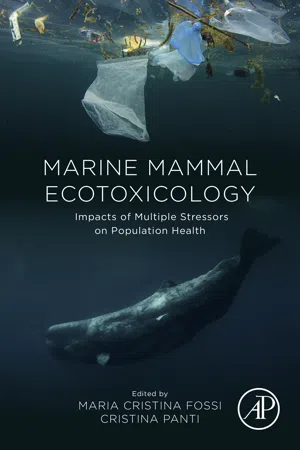
Marine Mammal Ecotoxicology
Impacts of Multiple Stressors on Population Health
- 512 pages
- English
- ePUB (mobile friendly)
- Available on iOS & Android
Marine Mammal Ecotoxicology
Impacts of Multiple Stressors on Population Health
About this book
Marine Mammal Ecotoxicology: Impacts of Multiple Stressors on Population Health provides tactics on how to develop a comprehensive methodology for the study of existing threats to marine mammals. By presenting a conservation-biology approach and new and emerging technologies, this work helps provide crucial knowledge on the status of marine mammal populations that not only helps readers understand the ecosystem's health, but also instigate mitigation measures. This volume provides information that helps investigators unravel the relationships between exposure to environmental stressors (e.g., climate change, pollutants, marine litter, pathogens and biotoxins) and a range of endpoints in marine mammal species.The application of robust examination procedures and biochemical, immunological, and molecular techniques, combined with pathological examination and feeding ecology, has led to the development of health assessment methods at the individual and population levels in wild marine mammals.- Provides a comprehensive, worldwide update and state of knowledge on current research and topics on marine mammal ecotoxicology- Includes coverage of both new and emerging technologies- Features a multidisciplinary approach that gives readers a broad, updated overview of the threats facing marine mammals and related conservation measures
Frequently asked questions
- Essential is ideal for learners and professionals who enjoy exploring a wide range of subjects. Access the Essential Library with 800,000+ trusted titles and best-sellers across business, personal growth, and the humanities. Includes unlimited reading time and Standard Read Aloud voice.
- Complete: Perfect for advanced learners and researchers needing full, unrestricted access. Unlock 1.4M+ books across hundreds of subjects, including academic and specialized titles. The Complete Plan also includes advanced features like Premium Read Aloud and Research Assistant.
Please note we cannot support devices running on iOS 13 and Android 7 or earlier. Learn more about using the app.
Information
Organochlorine Contaminants and Reproductive Implication in Cetaceans
A Case Study of the Common Dolphin
Abstract
Keywords
Introduction
Table of contents
- Cover image
- Title page
- Table of Contents
- Notices
- List of Contributors
- Foreword
- List of Abbreviations
- Section I. Legacy and Emerging Contaminants in Marine Mammal Populations
- Section II. Effects of Toxicological and Cumulative Stress on Marine Mammal Health
- Section III. Implication for Monitoring and Conservation of Marine Mammals
- Index